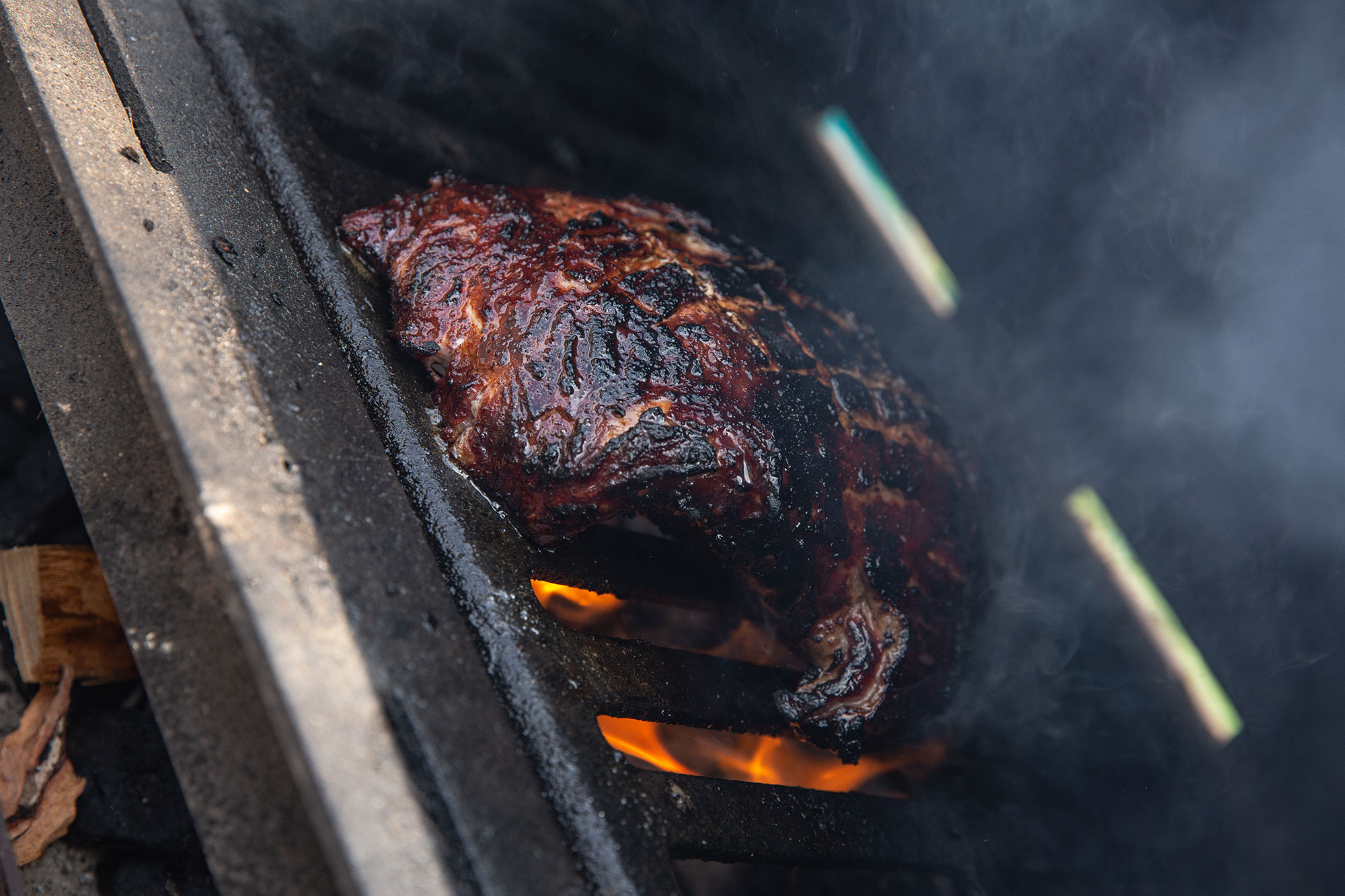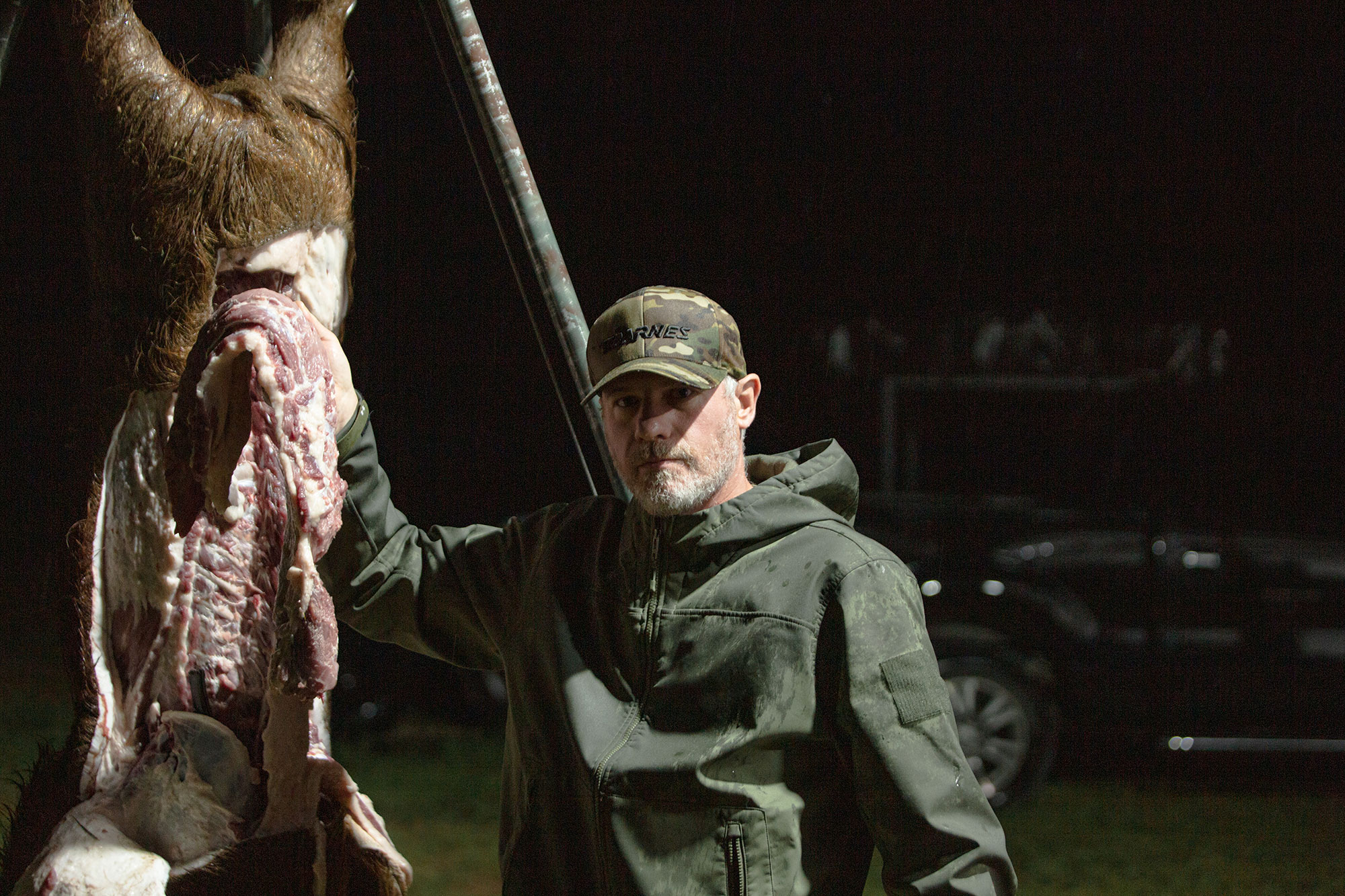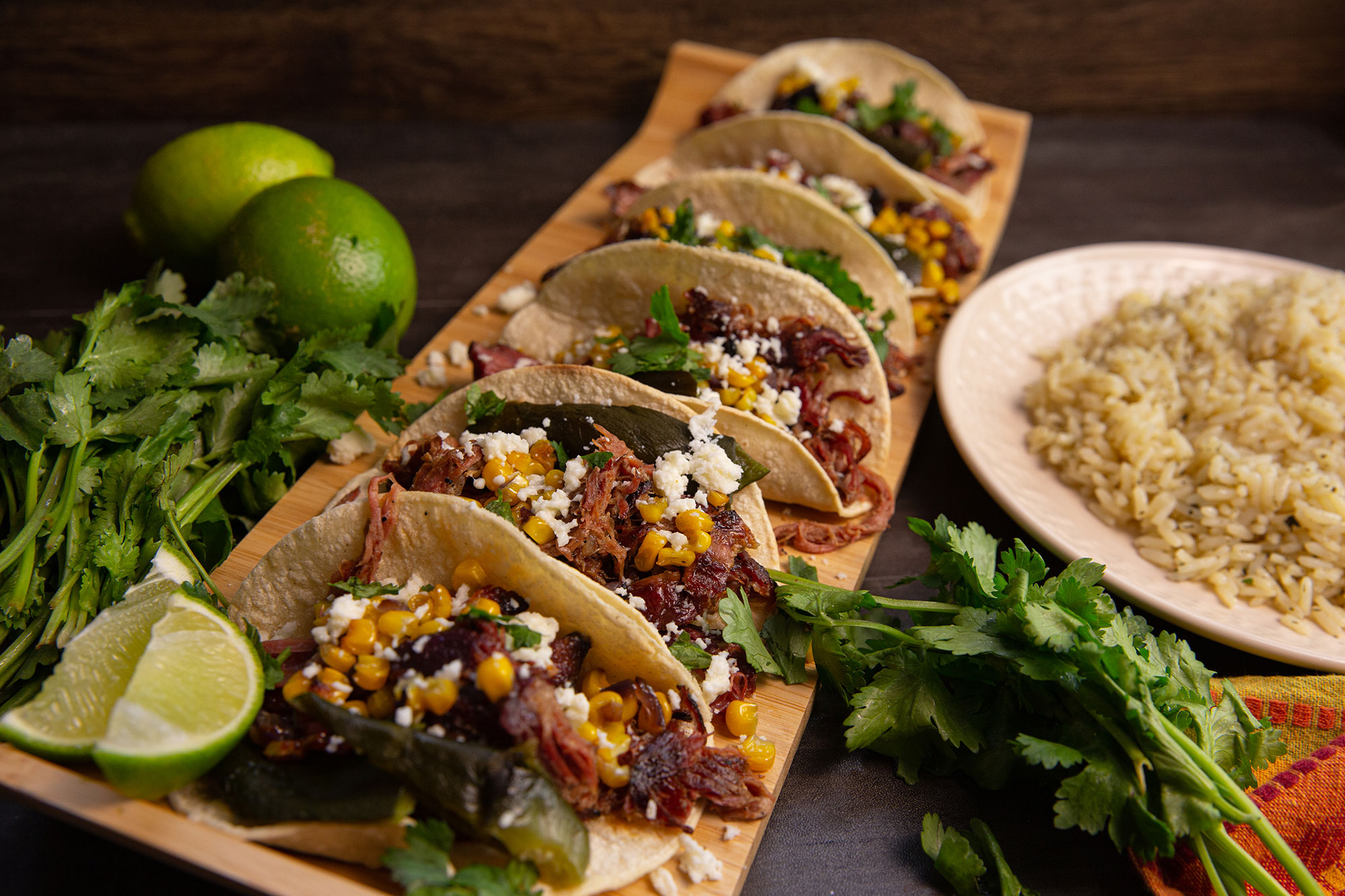My first experience with wild hogs dates back to a media hunt in Texas a few years ago. Michael Hunter, a renowned wild game chef, returned to camp with a good-sized boar that didn’t quite break the 200-pound mark. The guide examined the shoulder and told Michael, “With a shield like that, you can’t eat him.”
I could see it in Michael’s eyes: the gauntlet had been thrown. He and another guide skinned and butchered the hog, then Michael brined a hindquarter in Morton Tender Quick overnight, spiced it the next evening with Bearded Butcher’s Butter Blend and smoked it in an offset for a few hours. He then carved it, and made that guide eat his words.
Even those big, smelly hogs, if cooked correctly, can exude flavor and drip succulence. Here we break down everything you need to know in order to properly and safely cook wild hog.
What’s the Difference Between Wild and Domestic Pigs?

Domestic pigs weren’t domestic in what is now the U.S. until Columbus brought them over in 1493. Free-range farming was practiced in some states through the 1950s. Also, during wars and economic downturns, farmers abandoned their homesteads and turned their livestock loose. In the 1930s, the Eurasian wild boar was introduced to Texas for sport hunting, as this species was smarter and more elusive. The pigs roaming free today are a mix of feral pigs and Eurasian wild boar. There are indeed differences in physical attributes among populations, but all are recognized by the same scientific name, Sus scrofa, and are considered an exotic invasive species (read our guide to hog hunting here).
While a domestic pig will generally eat only corn, soybeans, and grains, a wild pig’s diet may also include animal matter, like reptiles, amphibians, fawns, rodents, worms, insects, or bird eggs. Still, a feral hog’s first love is everything and anything a farmer can grow. They will methodically work down crop rows, feeding as they go and eroding soil.
Wild hogs will taste different than domestic pigs due to the differences in breeding, genetics, and diet. But that isn’t necessarily a bad thing. We humans weren’t meant to eat what sits on a grocer’s shelves—meat that’s been gorged on corn and other supplements and stabbed with antibiotics and growth hormones. Nevertheless, the consumption of grocery store meat can adversely train tastebuds. It’s why your non-hunter neighbor thinks deer tastes “gamey.” They aren’t accustomed to the taste of wild meat. But the more you eat wild game, the more those tastebuds get recalibrated and the more you’ll appreciate that “gamey” taste.
My experience has been that wild pig will have a wild taste, but also a hint of maple flavor. It will taste similar to the pork you know and love. Interestingly, while you’re butchering a feral hog you might notice that maple smell. This indicates the pig is still fresh, says Micah Merz of Texas JAGD, our host for a recent hog hunt. He told me this while we were quartering a hog at 3 a.m. There was debate among our hunting crew whether a hog that had been sitting dead in the dirt since midnight in the May Texas heat would have spoiled. That slight hint of maple smell told us it hadn’t.
Do Wild Hogs Spread Disease?

The short answer is yes. But the longer answer is that distinct preparation steps will significantly lower—likely eliminate—all risks. Diseases could include swine brucellosis, pseudorabies, leptospirosis, and trichinosis. Pseudorabies isn’t known to affect humans, but can kill dogs if exposed. Trichinosis comes in several species of parasitic roundworms. The variety found in domestic hogs is killed with 10 days in a deep freezer, but the kind potentially found in wild hogs can still persist after a thorough freeze. However, it is accepted that cooking wild hog to 145 degrees Fahrenheit will kill all trichinosis.
For more details on feral hog diseases, the Oregon Department of Fish and Wildlife offers great insight here.
If you’re still concerned with risks, wear gloves while field dressing and butchering, keep the dogs away, and cook the meat to 170 degrees Fahrenheit or higher. If for some reason you feel ill after eating or handling wild hog, visit a doctor sooner rather than later.
Skinning and Butchering a Wild Hog

Butchering a wild hog is far more difficult than cutting up a deer. In the field, some hunters opt to pull only backstraps and perhaps a hindquarter, leaving the rest for coyotes and buzzards (and maybe other hogs). When dangling from a skinning pole, a wild hog gets a little easier to skin and break down, but the hide is still thick and the fat layer between meat and hide is also thick, especially on bigger hogs.
A sharp, quality knife that holds an edge is crucial. If you have access to some sort of mechanism to help pull off the hide, you’re at an advantage. Otherwise, you may easily spend an hour or more trimming back hide to get access to the meat.
READ NEXT: Best Skinning Knives
When I’ve got a hog dangling from a hook but no mechanical help pulling the hide, I might only get the primal cuts: all quarters, backstraps, and tenderloins. Neck, flanks, and trim require a greater commitment in terms of muscle and time, but I always advocate for it when possible.
How to Cook Wild Hog
How you cook wild hog will vary, depending on the cut. Here are some general guidelines for cooking the major cuts and offal.
Backstrap, Tenderloin, Roasts, and Steaks from Hindquarter

Season well with your favorite BBQ spice blends. I am a fan of anything from Meat Church for wild hogs. Season liberally and let it sit overnight in the fridge. The cooking process itself could begin with a sous vide at 130 F for 3 to 5 hours, depending on size of the cut, or even a smoke at 160 for 3 hours to bring the hog cut to 125 or 130 F. Follow up with a hot, hot sear to crisp up the outside. Let rest for 15 minutes. Use a meat probe to make sure it’s 145 F or above (to prevent trichinosis) before carving and serving. If the meat still isn’t warm enough, put it back on the smoker or in oven at 200 F. Once it hits 140 F, pull and let rest again, but for 10 minutes this time.
READ NEXT: Best Guns for Hog Hunting
A note regarding the fat layer on backstraps: Especially at the bottom half, closer to rump of hog, you’ll likely find there is a layer of fat that is separate from the loin itself. You can indeed keep this on to allow those fatty juices to drip and keep meat moist, especially when smoking, but make sure to rub in spices between that fat cap and the actual loin. Also, you want to cut that off when searing, since that pure fat will burn before the backstrap cooks.
Front Quarters, Neck, and Trim Meat
These are your harder-working muscles riddled with collagen. Collagen only starts to break down and melt at 160, but it will also harden first and gradually turn to gelatin over longer periods of time. So, no, a wild hog shoulder smoked at 225 until it hits 165 will not produce tender meat. I have left a front wild hog shank in a sous vide at 180 F for upwards of 14 hours then seared it and was happy with how tender it became.
So treat these cuts as you would a pork butt or beef brisket. Low and slow is key. Don’t work over 225 F if smoking. Spritz with a 50:50 mix of apple cider vinegar and apple juice every half-hour and plan on it taking several hours. You can indeed break down the meat into small cuts or chunks and that will lower the overall time required to cook. The final internal temp goal is 205 F. It’s really no different than the finish line for a pork butt or beef brisket.
Offal
With the innards or even the gonads off a big boar, you can serve up some of these bits. Preparing wild hog testicles is the same as venison rocky mountain oysters, though, in my experience, they’re about 3 to 4 times bigger.
READ NEXT: Best Calibers for Hog Hunting
Any favorite beef or venison liver recipe will also work for wild hog. But don’t keep the intestines thinking you can use them for wild-hog casings. I’ve worked with renowned and award-winning sausage chefs and have been told that even for domestic pigs: “It’s not worth the effort.”
An Easy Wild Hog Taco Recipe

Ingredients (8 to 12 servings):
- 3-5 pounds wild pork, cut into approximate 2-inch cubes
- Meat Church Honey Bacon BBQ Blend
- Spray bottle with mix of 50:50 apple-cider-vinegar to apple juice
- Roasted corn and minced red onion
- Roasted poblanos, cut into strips
- Cotija cheese
- Freshly chopped cilantro
- Fresh lime slices
- Corn tortillas (three per serving), lightly toasted in oven
Crock Pot Contents:
- Smoked wild pork chunks (see instructions)
- 1/4 cup apple cider vinegar
- 1 cup pineapple juice
- 1/2 cup Coca-Cola hencho en Mexico (made with sugar cane, not corn syrup)
- Chop any cut of wild pork or trim into fist-sized chunks. Season well and refrigerate overnight.
- Smoke chunks for 3 hours at 160 F, spritzing with 50:50 mix every hour.
- Remove and sear all pieces over an extra-hot grill (preferably open flame, perhaps charcoal with chunks of mesquite mixed in) until slightly charred.
- Add to a Crock Pot, add apple cider vinegar, pineapple juice, Mexican Coca-Cola, cover, and set to low for 6 hours.
- Roast corn and minced red onion mix at 400 F for 15-20 minutes until slightly brown. Remove and set aside.
- Roast poblanos at 400 F for 15-20 minutes until outside is slightly charred and skin is loose. Remove peppers and add to bowl, cover and sweat in the fridge for half hour or more. Remove, seed, and peel peppers. Slice until 2-inch strips and set aside.
Thoughts or questions? Reach out to me on Instagram (@WildGameJack) with any questions or comments.








